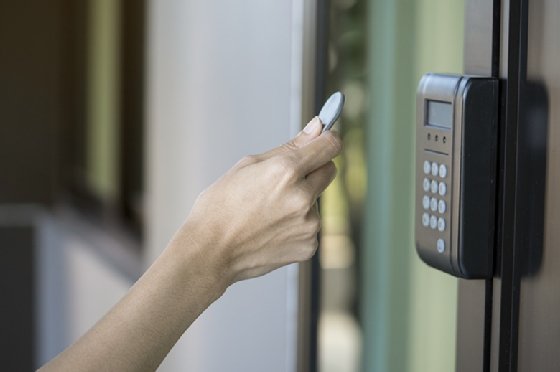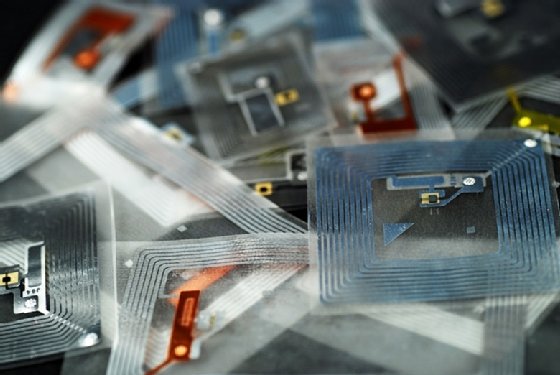RFID tagging
RFID tagging uses small radio frequency identification devices to track and identify objects. An RFID tagging system includes the tag itself, also known as a transponder; a scanning antenna and receiver, often combined into one reader, also known as an interrogator; and a host system application for data collection, processing and transmission.
Such systems are commonly used for the tracking and management of goods, animals and humans.
History of RFID tagging
RFID can be traced to the early days of radio and later the invention of radio detection and ranging (RADAR) in 1935 by Sir Robert Watson-Watt. The use of radio waves to detect enemy aircraft dates back to World War II. RFID as recognized today appeared in the 1940s and 1950s, with applications beyond military use starting in the 1960s. Charles Walton is documented as the first RFID patent holder for his 1973 design of a portable radio frequency emitting identifier, the patent for which was awarded in 1983. He was the first to use the RFID acronym.
The high cost of tags and readers largely prohibited the early widespread commercial use of RFID. As hardware costs decreased, RFID tagging adoption increased and began to see commercial use in the late 1970s and 1980s. Continued enhancements, such as improved technology to miniaturize RFID hardware, led to further use of RFID. In 2003, the U.S. Department of Defense announced the release of its Radio Frequency Identification Policy, which proposed standardizing an Electric Product Code (EPC) to identify DoD shipments. Beginning in 2005, DoD suppliers were required to mark their shipments with passive RFID tags.

Following the DoD, retailer Walmart began using EPCs at some of its stores and a regional distribution center in 2005 in conjunction with manufacturers, including HP Inc., Johnson & Johnson Services Inc., Kimberly-Clark Corp., Kraft Foods Group Inc., Nestle Purina Petcare, Proctor & Gamble Co. and Unilever. The project was abandoned in 2009 and highlighted some of the challenges of RFID tagging and its implementation.
Due to lessons learned from Walmart and the continued drop of tag prices, a number of retailers have implemented successful RFID projects in the past two decades. Reports claim the tags that cost 50 cents to $1 apiece in the early 2000s, cost about 3 to 10 cents today. Macy's uses RFID tags to track items across its stores and fulfillment centers, and in 2017, Target Brands Inc. deployed RFID technology in more than 1,600 stores to improve inventory management, after initially launching an RFID smart label deployment on its price tags in 2015.
RFID applications extend beyond retail. Delta Air Lines Inc., for example, uses RFID tags to track passengers' luggage and to manage emergency equipment on aircraft and track airplane parts inventory.
Walt Disney World Resorts uses RFID technology in its MagicBand wristbands, allowing visitors to unlock their hotel rooms, make purchases at select locations, and access attractions and shows.
Purdue Pharma L.P. became the first company to put individual RFID tags on bottles of its painkiller OxyContin to ensure patient safety and combat drug diversion and counterfeiting in 2003. In another medical use, Liverpool Hospital began using RFID tagging in 2013 to track blood product inventory and ensure the safety of its temperature-sensitive supplies.
In an industrial use case, after deploying a successful RFID-based worker safety program in 2009, steelmaker Posco started using RFID on its products in 2011 to identify and trace multi-ton steel plates, automating inspection, packaging and shipping from the manufacturing floor to the end customer.
Uses and applications
The most common RFID application is to track and manage goods and people in industries ranging from healthcare and industrial to manufacturing, retail and business. These applications include:
- Access control
- Asset tracking
- Counterfeit prevention
- Document tracking
- ID badging
- Inventory management
- Logistics
- Personnel tracking
- Supply chain management
RFID is widely used in the supply chain as an alternative to barcode technology. Although more expensive than barcode stickers, RFID tags don't get dirty or fall off, and they don't require an unobstructed line of sight between the tag and reader.
Injectable RFID tags have been used to track wildlife and livestock, and even for human use. For example, injectable RFID tags can help medical personnel identify a patient who is unable to speak and even provide access to the person's medical records.

Design
An RFID system contains a transponder, interrogator and the host applications. RFID systems generally provide one-way communication, with a transponder transmitting data to the interrogator.
Transponders, or the RFID tags, consist of a microchip, memory and antenna. Active RFID tags have their own power source (often battery), while passive tags have no power source, and are activated by the RF scan of the interrogator. As a result, active tags have more memory and can generally be read at greater ranges. In semi-passive RFID tags, a battery runs the circuitry while communication is powered by the RFID reader. Tags can be read-only or have read-write capabilities.
Smart labels, or smart tags, have emerged as a category of specially configured flat RFID tag that can be inserted into an item identification slip. Smart labels can be used to detect parameters in shipped goods, including temperature, shock, tilt, vibration and more.
Printable RFID tags use a low-power integrated circuit (IC) with an antenna and can be printed on demand from RFID smart label printers/encoders that embed the tag into the label material.
Depending on the application, RFID tags can cost less than 10 cents or up to $50 apiece.
RFID readers, or interrogators, are the devices that gather data from the tags. RFID readers are network-connected and can be permanently attached or portable devices. They use RF waves to transmit signals to activate RFID tags. Once activated, the tag sends a wave back to the reader, where it is translated. RFID tags do not have to be scanned directly and do not require line of sight with an interrogator. The range at which a reader can transmit with a tag depends on the frequency used.
RFID host computers or networks are where the collected data is read, processed and passed onto the appropriate application for analysis and further use. Many RFID readers also contain onboard processing, running applications rather than relying on a host computer, or store the data until it can be uploaded to the host.
Challenges
RFID tagging is somewhat controversial, as tags can theoretically be cloned or used for illicit tracking. Another concern is that RFID tag data can be read by anyone with a compatible reader. Additionally, tags can sometimes be read after an item leaves a store or the supply chain. Tags can also be read without a user's knowledge, and it if has a unique serial number, it can be associated to a particular person. This is a privacy concern for individuals, while in military or medical scenarios it can be a national security issue or life-or-death matter.
Unfortunately, because RFID tags don't have a lot of compute power, they are unable to accommodate encryption. One exception to this is the RFID tags used in passports, basic access control (BAC). These chips have sufficient compute power to decode an encrypted token from a reader to validate the reader, and as a result, share the information in the tag. This is a sophisticated use case and often cost-prohibitive for other applications, however.
Beyond security and privacy, RFID tagging systems have two main issues: reader collision and tag collision. Reader collision -- when a signal from one RFID reader interferes with a second reader -- can be prevented by using an anti-collision protocol to make RFID tags take turns transmitting to their appropriate reader. Tag collision occurs when too many tags confuse an RFID reader by transmitting data at the same time. Choosing a reader that gathers tag info one at a time can prevent this issue.
RFID standards and regulations
RFID technology has a number of guidelines and specifications, the main ones being the International Organization for Standardization (ISO), Electronics Product Code Global Incorporated (EPCglobal) and International Electrotechnical Commission (IEC).
Each radio frequency has associated standards, including ISO 14223 and ISO/IEC 18000-2 for low-frequency RFID, ISO 15693 and ISO/IEC 14443 for high-frequency RFID, and ISO 18000-6C for ultra-high-frequency RFID.
In the U.S., RFID regulations are covered in by the Federal Communications Commission's Code of Federal Regulations part 15, section 15.247. In the EU, regulations include ETSI EN 300-220 and ETSI EN 302-208. Regulations may include the frequency at which authorized RFID applications can run in certain frequency ranges, maximum wattage allowed, reader-to-tag communication techniques, and channels/channel spacing, which involves how a frequency range is divided and involves preventing reader-to-reader interference.
RFID alternatives
The use of RFID tagging as an alternative to barcodes is increasing. While barcodes require direct line of sight and closer proximity than an RFID tag, they also take longer to read, are not read-write and represent a product type versus the individual product represented by an RFID tag. Barcodes are a much cheaper alternative to RFID tags, however. While different from a standard barcode, quick response (QR) codes are also cheaper than RFID codes, but they require direct line of sight and may not be suitable for all RFID applications.
Near-field communication and RFID are very similar and used for similar applications, but NFC offers two-way communication, enabling card emulation and peer-to-peer sharing. And while NFC operates at the same frequency as high-frequency RFID, NFC-enabled devices must be closer in proximity as NFC has a shorter read range. NFC is often used for access control and contactless payments, among other uses.
Bluetooth Low Energy (BLE) tags are similar to active RFID tags, as they have built-in batteries and offer long read ranges, but they also offer two-way communication, unlike most RFID. BLE-enabled tags are increasingly viewed as a more energy efficient alternative to RFID. BLE tags are more costly than passive RFID tags, however, though pricing is on par with some active RFID tags.








